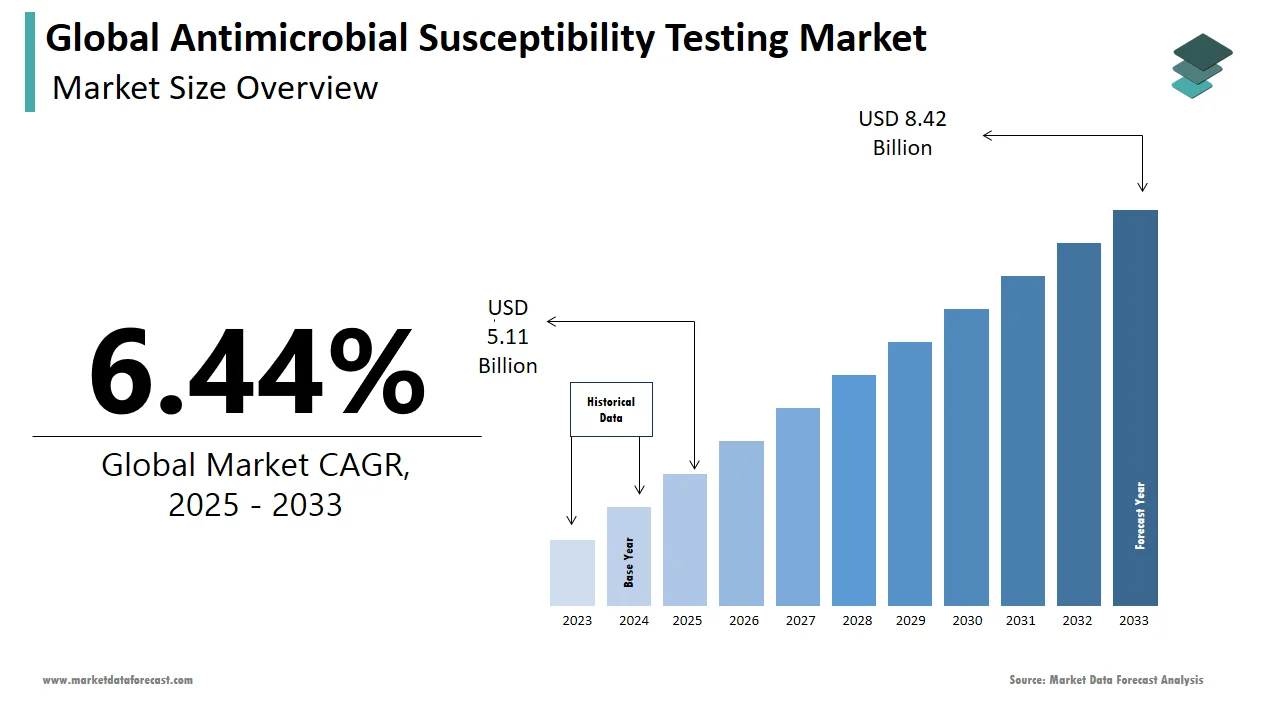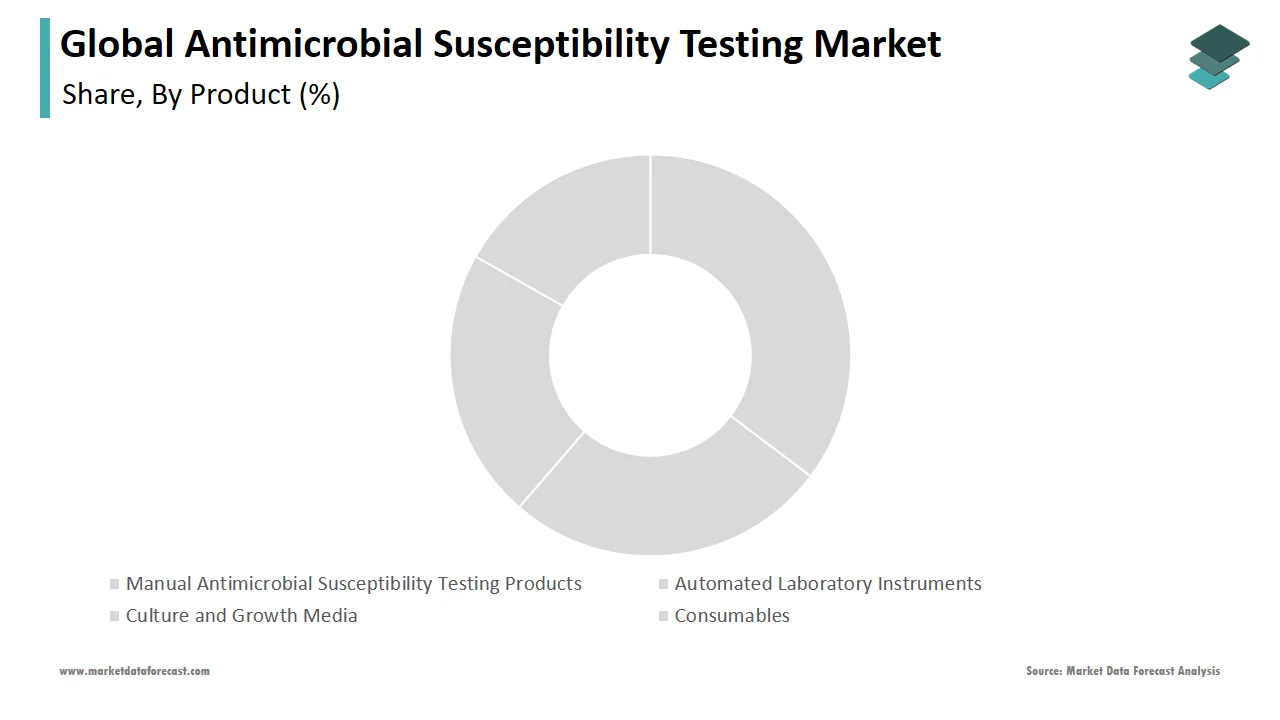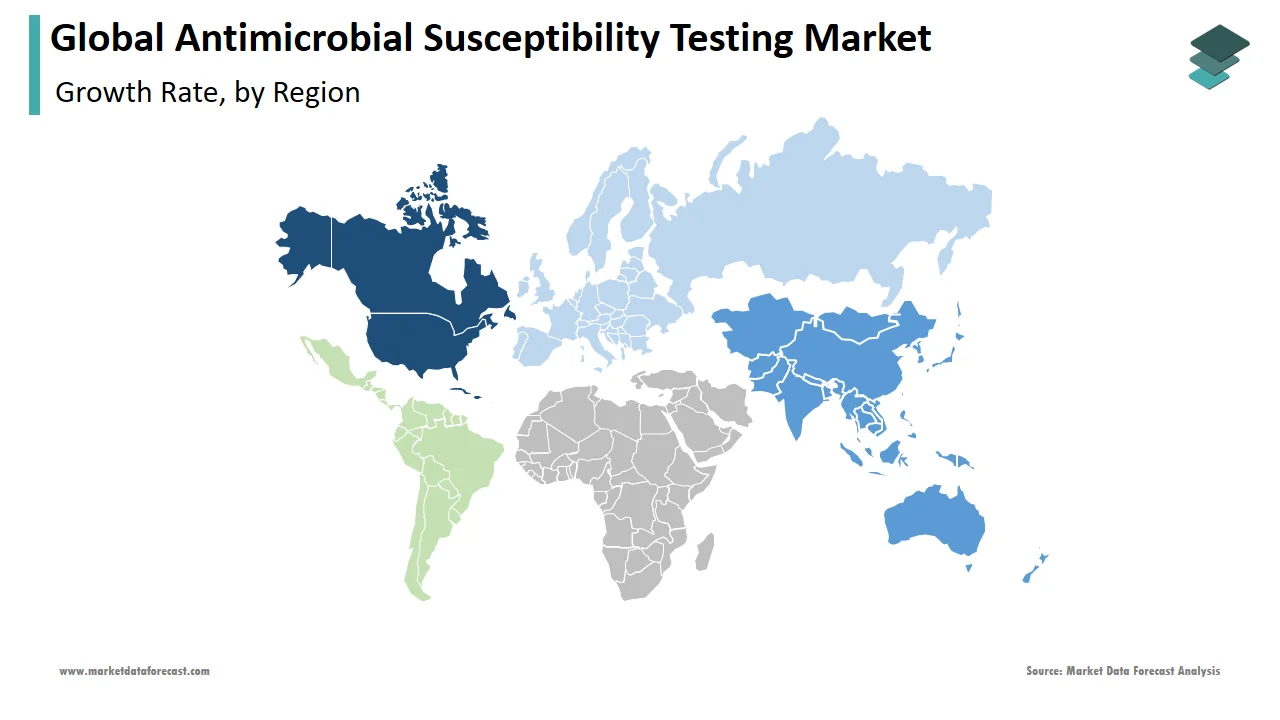Global Antimicrobial Susceptibility Testing Market Size, Share, Trends & Growth Forecast Report By Product, Application, End User and Region (North America, Europe, Asia-Pacific, Latin America, Middle East and Africa), Industry Analysis From 2025 To 2033.
Global Antimicrobial Susceptibility Testing Market Size
The size of the global antimicrobial susceptibility testing market was worth USD 4.8 billion in 2024. The global market is anticipated to grow at a CAGR of 6.44% from 2025 to 2033 and be worth USD 8.42 billion by 2033 from USD 5.11 billion in 2025.

Antimicrobial susceptibility testing (AST) is a laboratory process to establish which antimicrobial regimen is specifically effective for individual patients performed by medical technologists. Susceptibility is when microorganisms such as bacteria and fungi cannot survive in the presence of one or more antimicrobial medicines. This testing is done on microorganisms such as bacteria and fungi causing the infection after being recovered in a specimen culture. It is one of the most basic forms that seeks to evaluate whether or not antibiotic treatment will be effective. These tests are conducted under strict guidelines. Antimicrobial susceptibility testing methods include disk diffusion and minimal inhibitory concentration (MIC) methods, such as broth microdilution, agar gradient diffusion, and agar dilution. To decrease the time to get results and improve workflow, MIC tests often utilize semi- or fully automated platforms.
MARKET DRIVERS
The increasing spread of Infectious diseases, Increased use of automated devices and antibiotics are primarily anticipated to boost the global antimicrobial susceptibility testing market.
The demand for antimicrobial susceptibility testing has been driven by the increasing prevalence of infectious disease epidemics such as Neisseria meningitides, Neisseria gonorrhoeae, Shigella, and Salmonella serotypes mainly due to lack of proper water supply, poor sanitation, and unsanitary conditions. In addition, automation is gaining popularity quickly with the development of advanced devices that track several pathogenic bacteria and other microorganisms. These results are accurate, fast, and have fewer inaccurate results. Within 4-6 hrs, these systems directly monitor the organism's growth and directly provide results from blood culture bottles. This is much lower than conventional testing procedures. All these factors are predicted to surge the development of the antimicrobial susceptibility testing market.Antibiotic overuse and misuse that results in antimicrobial resistance (AMR) and the growing usage of antimicrobial susceptibility testing by biopharmaceutical, biotechnological, and pharmaceutical industries are further projected to fuel the growth rate of the AST market.
Rising awareness programs, an increase in the prevalence of multidrug-resistant organisms, improved healthcare infrastructure, high-quality hospital infrastructure, rising prevalence of hospital-acquired infections (HAIs), a rise in patient population base, increased healthcare needs, rapidly expanding geriatric population that leads to a rise in chronic diseases are also expected to favor the market growth during the forecast period. In addition, initiatives for personalized medicine, the availability of various manual products, and a rise in the prevalence of antimicrobial resistance in populations motivate the key market participants to focus more and are expected to act favorably on the growth rate of the market.
MARKET RESTRAINTS
Strict regulatory government policies, the high cost of automated systems, and the issues involved with antimicrobial susceptibility testing are expected to restrain the market during the forecast period. In addition, the challenges faced by the antimicrobial susceptibility testing market are the time difference between clinical breakpoints, approval of new antimicrobial agents, and unawareness of antimicrobial susceptibility testing.
Impact Of Covid-19 On The Antimicrobial Susceptibility Testing Market
The current global COVID-19 pandemic has severely impacted healthcare markets in either a positive or negative way. Prescribers used antibiotics indiscriminately to treat and prevent presumed bacterial co-infections in COVID-19. Furthermore, antimicrobial resistance (AMR) surveillance and AMS have reduced importance because of the diversion of health system resources to the pandemic response. The limited access to current users has significantly reduced market players' manufacturing of new AST systems and implementation of previously sold systems, thereby reducing the growth of consumable test kits. However, the gradual slowdown of the pandemic and the irrational use of antimicrobials during the pandemic is driving the antimicrobial susceptibility testing market.
REPORT COVERAGE
|
REPORT METRIC |
DETAILS |
|
Market Size Available |
2024 to 2033 |
|
Base Year |
2024 |
|
Forecast Period |
2025 to 2033 |
|
CAGR |
6.44% |
|
Segments Covered |
By Product, Application, End-User, and Region. |
|
Various Analyses Covered |
Global, Regional, and country-level analysis; Segment-Level Analysis, DROC; PESTLE Analysis; Porter’s Five Forces Analysis, Competitive Landscape; Analyst Overview of Investment Opportunities |
|
Regions Covered |
North America, Europe, APAC, Latin America, Middle East & Africa |
|
Market Leaders Profiled |
Thermo Fisher Scientific Inc. and BIOMÉRIEUX, Bio-Rad Laboratories, Inc., Bruker, Nissui Pharmaceutical Co., Ltd., ELITechGroup, Flinn Scientific, CONDALAB, HiMedia Laboratories, Alifax S.r.l. Italy, Creative Diagnostics, Resistell AG, Danaher, Becton, Dickinson and Company, Merck KGaA, Synbiosis, Mast Group Ltd., Accelerate Diagnostics, Inc., and Zhuhai DL Biotech Co., and Others. |
SEGMENTAL ANALYSIS
By Product Insights

The automated laboratory instruments segment accounted for the largest share of the global antimicrobial susceptibility testing market in 2022. This is due to technological advancements and rising R&D investments by key players to deliver novel technologies in the market are factors driving the segment's growth.
By Application Insights
The clinical diagnostics segment accounted for the largest share in the global AST market owing to the rising prevalence of infectious diseases, increasing incidence of HAIs, the growing procedural of clinical diagnostic tests, rising early disease diagnosis across significant markets, and the introduction of various technologically advanced susceptibility testing products.
By End-User Insights
Based on the end-user, the hospitals and diagnostic centers segment dominated the market for antimicrobial susceptibility testing worldwide in 2022 and are expected to continue this trend during the forecast period due to growing HAIs, incidences of antimicrobial resistance, and the need to develop new treatment methods.
REGIONAL ANALYSIS

North America is predicted to dominate the global antimicrobial susceptibility testing market throughout the forecast period. Factors such as the rising incidence of antibiotic-resistant infections, awareness programs, increased research and development, and increased regional government initiatives drive the market forward. The U.S is dominating in North American market due rise in epidemic and pandemic events and the presence of advanced healthcare infrastructure. According to CDC, in the United States, around 2.8 million get infected with antibiotic-resistant infections each year; as a result, more than 35,000 people die. Furthermore, 223,900 cases of Clostridioides difficile happened in 2017, and at least 12,800 people died. According to the Centers for Disease Control and Prevention, more than 2.8 million antibiotic-resistant infections occur in the United States annually, and more than 35,000 people die. In addition, the increasing number of multidrug-resistant diseases increases the need for antimicrobial susceptibility testing.
Asia-Pacific is expected to experience significant growth, owing to an increase in the overall population, a rising number of epidemic outbreaks caused by infectious pathogens, growing demand for minimum inhibitory concentration in antibiotic susceptibility testing conducted in a medical laboratory, and an increase in the awareness initiatives for antimicrobial resistance and increased investments in the healthcare sector in the region. China and India in the Asia-Pacific region are expected to dominate the areas because key companies such as Thermo Fisher Scientific Inc have entered the market.
Europe is expected to have the third-highest growth rate due to the region's increasing demand for fitness and health-tracking devices. However, the European market is dominated by Germany due to the rise in epidemic and pandemic events.
Latin America is expected to account for a substantial share of the global market during the forecast period owing to the rising investments in developing novel methods, the presence of sophisticated healthcare infrastructure for testing, and increasing funding. Brazil is dominating in Latin American market.
KEY MARKET PLAYERS
Thermo Fisher Scientific Inc. and BIOMÉRIEUX, Bio-Rad Laboratories, Inc., Bruker, Nissui Pharmaceutical Co., Ltd., ELITechGroup, Flinn Scientific, CONDALAB, HiMedia Laboratories, Alifax S.r.l. Italy, Creative Diagnostics, Resistell AG, Danaher, Becton, Dickinson and Company, Merck KGaA, Synbiosis, Mast Group Ltd., Accelerate Diagnostics, Inc., and Zhuhai DL Biotech Co., Ltd are some of the notable players in the global antimicrobial susceptibility testing market profiled in this report.
RECENT MARKET HAPPENINGS
-
In 2020, the FDA gave clearance to the Lefamulin 0.016-256 MTS (MIC Test Strip) of Lefamulin to enter the market in the United States.
-
In 2019, First Automated System for Bacterial Culture and Susceptibility Testing was introduced by Alifax S.r.l.
- The ASTar System, a rapid antimicrobial susceptibility testing (rAST) system that produces real minimum inhibitory concentration (MIC) results in less than 6 hours, was launched in 2021 by Thermo Fisher Scientific and Q-linea. Traditional AST procedures can take up to 72 hours to produce results.
MARKET SEGMENTATION
This research report on the global antimicrobial susceptibility testing market has been segmented and sub-segmented based on the product, application, end-user, and region.
By Product
- Manual Antimicrobial Susceptibility Testing Products
- Susceptibility Testing Disks
- MIC Strips
- Susceptibility Testing Plates
- Automated Laboratory Instruments
- Culture and Growth Media
- Consumables
By Application
- Clinical Diagnostics
- Drug Discovery and Development
- Epidemiology
By End-User
- Hospitals and Diagnostic Centers
- Pharmaceutical and Biotechnology Companies
- Research &Academic Institutes
- Clinical Research Organizations
By Region
- North America
- Europe
- Asia-Pacific
- Middle East Africa
- Latin America
Frequently Asked Questions
How much was the global antimicrobial susceptibility testing market valued at in 2024?
The global microbial susceptibility testing market size was worth USD 4.8 billion in 2024.
What is the projected to value of antimicrobial susceptibility testing market value in Europe by 2033?
The Europe antimicrobial susceptibility testing market is estimated to be valued USD 8.42 billion by 2033.
Which region is growing the fastest in the global antimicrobial susceptibility testing market in the future?
Geographically, the APAC region is estimated to witness the fastest CAGR of 8.37% from 2025 to 2033.
Who are the major players in the antimicrobial susceptibility testing market?
Companies playing a key role in the antimicrobial susceptibility testing market are Danaher Corporation, Becton, Dickinson, and Company., Bio-Rad Laboratories, Inc., Thermo Fisher Scientific Inc., HiMedia Laboratories Pvt. Ltd., Merlin Diagnostika GmbH, bioMerieux S.A., Merck KGaA, Accelerate Diagnostics, Inc., and Creative Diagnostics.
Related Reports
Access the study in MULTIPLE FORMATS
Purchase options starting from
$ 2500
Didn’t find what you’re looking for?
TALK TO OUR ANALYST TEAM
Need something within your budget?
NO WORRIES! WE GOT YOU COVERED!
Call us on: +1 888 702 9696 (U.S Toll Free)
Write to us: sales@marketdataforecast.com
